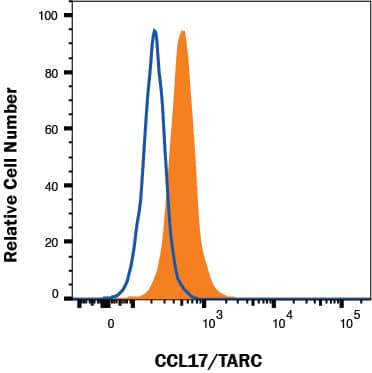Human CCL17/TARC PE-conjugated Antibody
R&D Systems, part of Bio-Techne | Catalog # IC3641P


Key Product Details
Species Reactivity
Validated:
Cited:
Applications
Validated:
Cited:
Label
Antibody Source
Product Specifications
Immunogen
Ala24-Ser94
Accession # Q92583.1
Specificity
Clonality
Host
Isotype
Scientific Data Images for Human CCL17/TARC PE-conjugated Antibody
Detection of CCL17/TARC in A549 Human Cell Line by Flow Cytometry.
A549 human lung carcinoma cell line was stained with Mouse Anti-Human CCL17/TARC PE-conjugated Monoclonal Antibody (Catalog # IC3641P, filled histogram) or isotype control antibody (IC002P, open histogram). To facilitate intracellular staining, cells were fixed with Flow Cytometry Fixation Buffer (FC004) and permeabilized with Flow Cytometry Permeabilization/Wash Buffer I (FC005). Staining was performed using our Staining Intracellular Molecules protocol.Applications for Human CCL17/TARC PE-conjugated Antibody
Intracellular Staining by Flow Cytometry
Sample: A549 human lung carcinoma cell line fixed with Flow Cytometry Fixation Buffer (Catalog # FC004) and permeabilized with Flow Cytometry Permeabilization/Wash Buffer I (Catalog # FC005)
Formulation, Preparation, and Storage
Purification
Formulation
Shipping
Stability & Storage
- 12 months from date of receipt, 2 to 8 °C as supplied.
Background: CCL17/TARC
CCL17, also called TARC, is a member of the CC chemokine family. CCL17 cDNA encodes a highly basic 94 amino acid (aa) residue precursor protein with a 23 aa residue signal peptide that is cleaved to generate the 71 aa residue mature secreted protein. Among CC chemokine family members, CCL17 has approximately 24‑29% amino acid sequence identity with CCL1, 2, 3, 4, 5, 7 and 8. The gene for human CCL17 has been mapped to chromosome 16q13 rather than chromosome 17 where the genes for many human CC chemokines are clustered. CCL17 is constitutively expressed in thymus, and at a lower level in lung, colon, and small intestine. CCL17 is also transiently expressed in stimulated peripheral blood mononuclear cells. Recombinant CCL17 has been shown to be chemotactic for T cell lines but not monocytes or neutrophils. CCL17 was identified to be a specific functional ligand for CCR4, a receptor that is selectively expressed on T cells.
References
- Imai, T. et al. (1997) J. Biol. Chem. 272:15036.
- Imai, T. et al. (1996) J. Biol. Chem. 271:21514.
- Nomiyama, H. et al. (1997) Genomics 40:211.
Alternate Names
Gene Symbol
UniProt
Additional CCL17/TARC Products
Product Documents for Human CCL17/TARC PE-conjugated Antibody
Product Specific Notices for Human CCL17/TARC PE-conjugated Antibody
For research use only